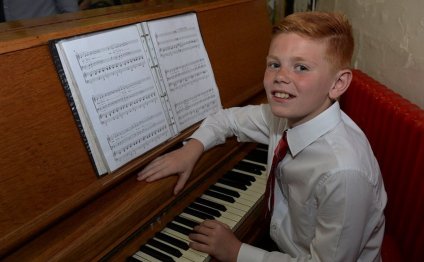
Cambrian Male Voice Choir
|
MUSICAL RHONDDA - A CULTURAL HISTORY Wales’s universal image as the “Land of Song” can be traced to the fusion of two easily discernible features of valley life in the mid to late 19th century – the strength of Nonconformity as a religious force and the frantic acceleration of the coal mining industry. Valleys such as the Rhondda were penetrated indiscriminately by those early pioneers, exploiting their mineral resources and transforming the valley floor into a vast black Klondike. While its workforce endured the dangers of working underground in the most appalling conditions, the communities in which they lived were galvanised by a musical intensity the like of which had never been seen before. For more than a century the Rhondda was famous for more than just its outpouring of precious bituminous fuel, it was the heartland of a culture inspired by the sound of people united in song. One of the 20th centuries most eminent Welsh composers, William Mattias, summed up the story of Rhondda choral music in Victorian times by saying, “The tradition of the 19th century Welsh choralism was as much a sociological as a musical phenomenon, arising out of the need of the people to express religious fervour or to rise above hardship and poverty through the means of choral singing. They are to be honoured for doing so. They and their leaders were in bond to their time in taking the only means open to them with results which were often inspiring.” Before the colliery wheels began turning, there were few places of public worship in the Rhondda. A parish church stood in Ton Pentre; there was an Independent Chapel in Cymmer, Nebo Baptist in Ystrad and Libanus in Treherbert were the few places where singing, usually unaccompanied hymns sung in unison, were performed. By 1752 there was obviously an interest in the art of choral singing in Ystradyfodwg when John Harry Evans was paid £1 a year as the new chorus master of the parish. A mere 951 people occupied the valleys in 1851, which swelled to an astonishing 172, 000 by 1924, and with this increase came the surge of interest in congregational singing. Chapels united in John Curwen’s ingenious tonic-solfa classes while Treherbert printer Isaac Jones showed his shrewd business sense as the first person in the valleys to print music in this simple method of musical notation.
Others came from the agricultural centres of the north and west where massed religious revivals had long-since swept the land, so it was no surprise that after a hard day’s shift underground, they congregated in the village pub at night and so the enjoyment of singing, to relieve themselves of the tensions of the day, was recognised. Although the Rhondda Fach did not musically develop to the same degree as the Fawr, choral singing spread rapidly throughout both valleys, usually resulting in the formation of the united town choirs and chapel choral societies, many of which grew to more than 300 voices. Rhondda grasped the concept of singing festivals, oratorios, cantatas and competitions in eisteddfodau which reached its climax in the national event every year. With a population density ten times the national average it was a haven of competitive gatherings where an eisteddfod marquee resembled a gladiatorial arena with reputations and village pride at stake.
He worshipped in Aberdare and with a group of local congregational chapels created a Choral Union that published "Llyfr Tonau" in 1859, a more accessible solfa singing book which sold 25, 000 copies almost immediately. In March 1861 he brought out his first edition of “Y Cerddor Cymreig”, a montly musical periodical. In addition to the articles and reports, each issue included a piece of classical choral music, with Welsh words, transposed to solfa. YOU MIGHT ALSO LIKE Cambrian Male Voice Choir_9
 Cambrian Male Voice Choir
 Cambrian Male Voice Choir_5
Share this PostRelated postsLlanelli Male Voice ChoirDECEMBER 25, 2025
A collection of Llanelli Male Choir’s best tracks sung in English, with songs from the shows, including Andrew Lloyd Webber’s… Read MoreMousehole Male Voice ChoirDECEMBER 25, 2025
Music Sponsorship It has been wonderful for the choir to receive support in the purchase of new music for out repertoire… Read More | |||||||||||











